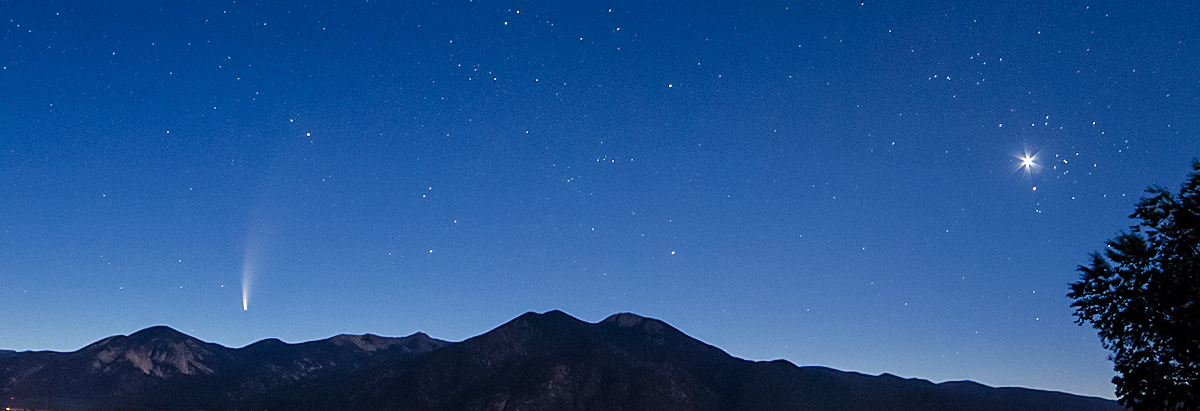
Welcome to taosastronomer.com!
offering
local "hands-on" observing
(visual and imaging) sessions and instruction
viewing and imaging from Rabbit Valley Observatory
a dark sky location on the mesa just west of Taos, NM
Astronomical Equipment and Cameras Used |
At Rabbit Valley Observatory, there are many options available from the equipment perspective. First and foremost, of course, are the main instruments and dome enclosure used. Pictured below is Rabbit Valley Observatory's dome and original main Celestron/Losmandy/Williams Optics Megrez instrument as well as the recently installed Explore Scientific OTA's (optical tube assemblies) as pictured below.
Rabbit Valley Observatory's SkyShed POD dome enclosure -- the dome can be just opened "halfway," or the entire "top" can be slid off (and to the right in this photo) to reveal the entire night sky -- a very nice option! |
Rabbit Valley Observatory's new and recently installed Explore Scientific ES127ED apochromatic refractor pier-mounted atop the venerable newly hyper-tuned upgraded Losmandy G-11 German equatorial mount and electronically guided by the piggybacked 60mm Astromania guidescope. |
Rabbit Valley Observatory's original main Celestron C-11 (now sold) instrument with Losmandy G-11 German equatorial mount and William Optics Megrez 80 guidescope/photographic 'scope, that was recently used for the 2017 total solar eclipse. |
Rabbit Valley Observatory's new and recently installed Explore Scientific AR152 achromatic refractor pier-mounted atop the Celestron Go-To electronically capable CGX GEM. It is anticipated that this rig will be used either visually or for video viewing employing the Atik Infinity video camera. |
Rabbit Valley Observatory very recently obtained a GSO 10-inch f/4 photo-visual reflector from respected dealer Agena Astro. Once a Rigel electric focuser is installed, the 'scope will be used as an alternative to the ES127ED, mounted on the CGX pictured in the adjacent photo. See the visual observing section for more details! |
Of course, once the dome is opened, the instruments may be used either visually or photographically. Such options are discussed in detail on the corresponding visual and imaging website pages. Here we will just consider an overview of the main equipment.
Once the scope is open to the sky, the observer needs to"find" the desired objects. The observer can reference RVO's (Rabbit Valley Observatory's) large permanent library and can also access digital sky charts and atlases inside the observatory. The setup also includes advanced digital setting circles which, once understood, can very easily assist the observer toward this end.
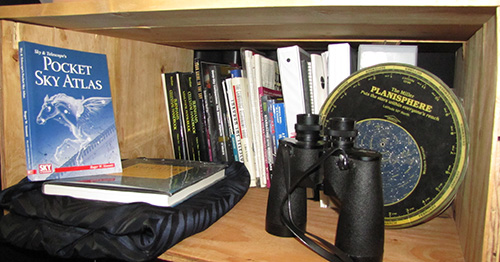 |
|
RVO's on-site mini-library -- one can also reference the huge additional library inside our house! |
RVO's digital setting circle controller -- made by the inventive JMI formerly of Lakewood, CO |
If one decides to observe either visually or photographically, the image must be focused, either on the digital chip of the camera or on the focal plane of your eye (the optic nerve). To accomplish this one must use rather precise focusing mechanisms. RVO incorporates both manual and electric focusers from JMI -- these are pictured below.
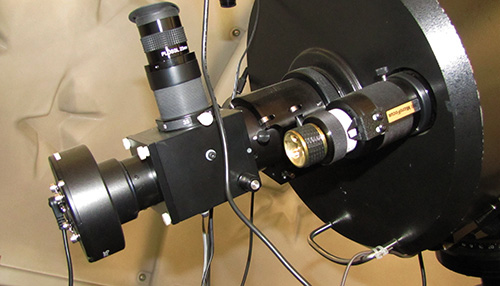 |
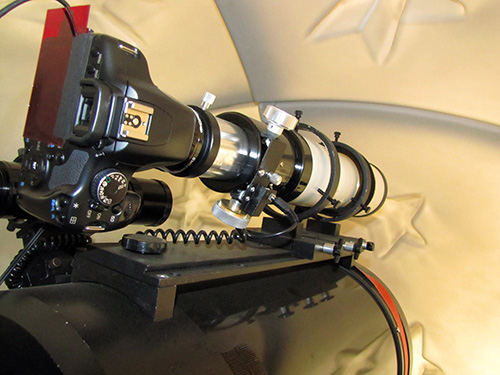 |
| JMI focusers on the original main Celestron C-11 instrument -- the one on the right is for "rough" manual focus (really quite accurate), the one in the middle is an extremely precise electric focuser, operated either from a hand (for visual observation) or computer (for photographic focusing) controller. (Note Orion G3 camera at far left.) As shown above, now the main photographic instrument is the superior Explore Scientific ES127ED apochromatic refractor. Recent guidescope is Astromania's 60mm finder/guidescope. | Electric JMI focuser on the original Megrez 80 guidescope. (Note Canon 450D XSi imaging camera at the rear of this optical train.) The Canon remains the primary imaging camera, but others are employed as well. See the imaging page of this website for more details. FYI, the Megrez 80 achromatic refractor was used to image the 2017 total solar eclipse, linked here.
|
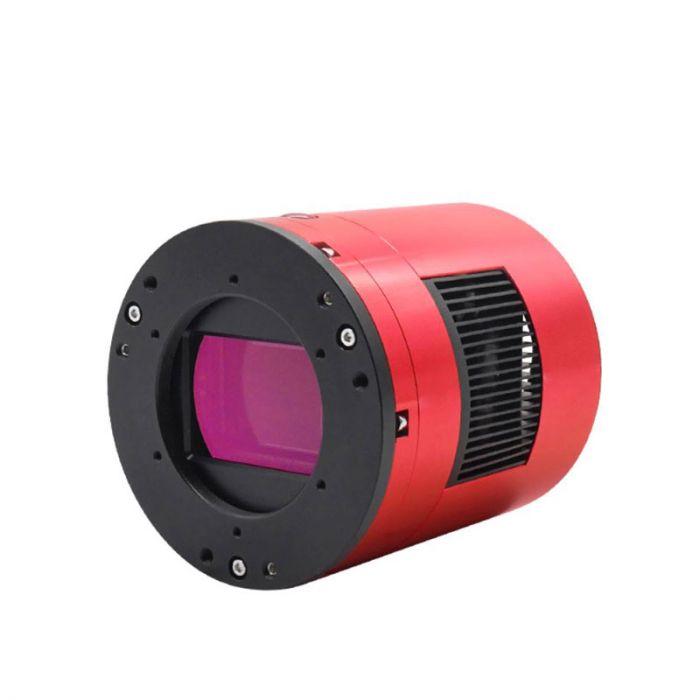 |
||
| New to RVO is the SBIG ST-8300 CCD; it is a one-shot color camera that is cooled to 30-40 degrees C below ambient, making it far more sensitive to dim deep-sky objects than the non-cooled Canon XSi camera shown above. Click the camera's image above to learn about this company's important, groundbreaking influence on CCD imaging. | The newest major camera at RVO is the top-of-the-line ZWO ASI 2400 MC Pro Cooled Color Camera. It is a USB3 full-frame one-shot-color camera, specifications linked here. It will likely take the place of the workhourse Canon 450DXsi imaging camera. | The Atik Infinity video camera is now employed and used "visually," with the view appearing not through the eyepiece, but rather on an on-site computer screen. Click this text to access the first visual/video observing session. Click this text to view recent images obtained using this technique. |
If one decides to observe visually, quality eyepieces are perhaps the most important accessory. Below are pictured some of RVO's eyepieces. the Tele Vue Naglers are consider the Rolls-Royce of deep-sky eyepieces; the University Optics Konigs not very far behind (I actually prefer these eyepieces)! For planetary viewing, the Orthoscopic style is preferred for razor-sharp to-the-edge views of fine planetary and lunar details.
Rabbit Valley Observatory's collection of vintage University Optics' Konigs and Orthos |
RVO's imagers include several Canon 450D/XSi imaging cameras -- modern DSLRs with large chips, modified to be more sensitive to the red light of nebulae and other deep-sky objects -- as well as the imaging and video cameras as pictured above. Guiding is now done with the excellent ZWO ASI120MM guiding camera. The cameras are controlled via laptop computer and a selection of sophisticated programs customized for astronomical use, discussed in greater detail in the imaging section of this website.
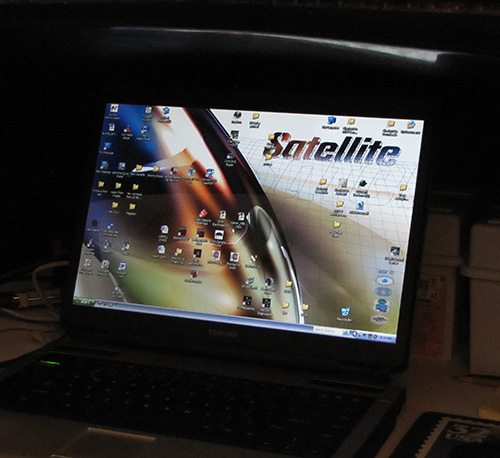 |
Rabbit Valley Observatory's aging but functional Toshiba laptop (recently replaced by a Dell model), running Windows XP -- a very stable astronomical platform. For video, a slightly newer Dell laptop running Windows 7 is employed. (In recent months this laptop has been replaced by the Dell Latitude e6530, which is more capable under Windows 10 to run the most recent astronomical programs.) RVO also employs a Fusion Windows 10 tablet, and a Lenovo Android tablet, mostly for automated "visual" use with the Celestron CGX mount. It is always necessary to upgrade.
|
So, if you decide to take advantage of this opportunity, your real decision is whether to observe visually or work to obtain a beautiful photograph(s) of a favorite object. Or, if you have the time, why not both! We hope to hear from you soon!
(all content copyright 2015-2021 Willis Greiner Photography, all rights reserved)